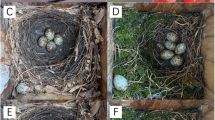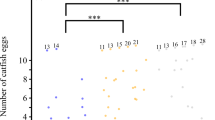Abstract
Avian brood parasites and their hosts provide model systems for investigating links between recognition, learning, and their fitness consequences1,2,3,4. One major evolutionary puzzle has continued to capture the attention of naturalists for centuries: why do hosts of brood parasites generally fail to recognize parasitic offspring after they have hatched from the egg5,6,7,8,9, even when the host and parasitic chicks differ to almost comic degrees7? One prominent theory to explain this pattern proposes that the costs of mistakenly learning to recognize the wrong offspring make recognition maladaptive10. Here we show that American coots, Fulica americana, can recognize and reject parasitic chicks in their brood by using learned cues, despite the fact that the hosts and the brood parasites are of the same species. A series of chick cross-fostering experiments confirm that coots use first-hatched chicks in a brood as referents to learn to recognize their own chicks and then discriminate against later-hatched parasitic chicks in the same brood. When experimentally provided with the wrong reference chicks, coots can be induced to discriminate against their own offspring, confirming that the learning errors proposed by theory can exist10. However, learning based on hatching order is reliable in naturally parasitized coot nests because host eggs hatch predictably ahead of parasite eggs. Conversely, a lack of reliable information may help to explain why the evolution of chick recognition is not more common in hosts of most interspecific brood parasites.
This is a preview of subscription content, access via your institution
Access options
Subscribe to this journal
Receive 51 print issues and online access
$199.00 per year
only $3.90 per issue
Buy this article
- Purchase on Springer Link
- Instant access to full article PDF
Prices may be subject to local taxes which are calculated during checkout



Similar content being viewed by others
References
Rothstein, S. I. A model system for coevolution—avian brood parasitism. Annu. Rev. Ecol. Syst. 21, 481–508 (1990)
Lotem, A., Nakamura, H. & Zahavi, A. Constraints on egg discrimination and cuckoo–host co-evolution. Anim. Behav. 49, 1185–1209 (1995)
Davies, N. B. & Welbergen, J. A. Social transmission of a host defense against cuckoo parasitism. Science 324, 1318–1320 (2009)
Langmore, N. E., Cockburn, A., Russell, A. F. & Kilner, R. M. Flexible cuckoo chick-rejection rules in the superb fairy-wren. Behav. Ecol. 20, 978–984 (2009)
Jenner, E. Observations on the natural history of the cuckoo. By Mr. Edward Jenner. In a letter to John Hunter, Esq. F. R. S. Phil. Trans. R. Soc. 78, 219–237 (1788)
Dawkins, R. & Krebs, J. R. Arms races between and within species. Proc. R. Soc. B 205, 489–511 (1979)
Davies, N. B. Cuckoos, Cowbirds and Other Cheats (T. & A. D. Poyser, 2000)
Grim, T. The evolution of nestling discrimination by hosts of parasitic birds: why is rejection so rare? Evol. Ecol. Res. 8, 785–802 (2006)
Soler, M. Co-evolutionary arms race between brood parasites and their hosts at the nestling stage. J. Avian Biol. 40, 237–240 (2009)
Lotem, A. Learning to recognize nestlings is maladaptive for cuckoo Cuculus canorus hosts. Nature 362, 743–745 (1993)
Rothstein, S. I. Successes and failures in avian egg and nestling recognition with comments on the utility of optimality reasoning. Am. Zool. 22, 547–560 (1982)
Davies, N. B. & Brooke, M. D. Cuckoos versus reed warblers—adaptations and counteradaptations. Anim. Behav. 36, 262–284 (1988)
Langmore, N. E., Hunt, S. & Kilner, R. M. Escalation of a coevolutionary arms race through host rejection of brood parasitic young. Nature 422, 157–160 (2003)
Britton, N. F., Planque, R. & Franks, N. R. Evolution of defence portfolios in exploiter–victim systems. Bull. Math. Biol. 69, 957–988 (2007)
Rothstein, S. I. Mechanisms of avian egg recognition: possible learned and innate factors. Auk 91, 796–807 (1974)
Strausberger, B. M. & Rothstein, S. I. Parasitic cowbirds may defeat host defense by causing rejecters to misimprint on cowbird eggs. Behav. Ecol. 20, 691–699 (2009)
Lawes, M. J. & Marthews, T. R. When will rejection of parasite nestlings by hosts of nonevicting avian brood parasites be favored? A misimprinting-equilibrium model. Behav. Ecol. 14, 757–770 (2003)
Sato, N. J., Tokue, K., Noske, R. A., Mikami, O. K. & Ueda, K. Evicting cuckoo nestlings from the nest: a new anti-parasitism behaviour. Biol. Lett. 10.1098/rsbl.2009.0540 (23 September 2009)
Lyon, B. E. & Eadie, J. M. A. Conspecific brood parasitism in birds: a life-history perspective. Annu. Rev. Ecol. Evol. Syst. 39, 343–363 (2008)
Lyon, B. E. Conspecific brood parasitism as a flexible female reproductive tactic in American coots. Anim. Behav. 46, 911–928 (1993)
Lyon, B. E. Egg recognition and counting reduce costs of avian conspecific brood parasitism. Nature 422, 495–499 (2003)
Lyon, B. E., Hochachka, W. M. & Eadie, J. M. Paternity–parasitism trade-offs: a model and test of host–parasite cooperation in an avian conspecific brood parasite. Evolution 56, 1253–1266 (2002)
Rothstein, S. I. Mechanisms of avian egg-recognition: additional evidence for learned components. Anim. Behav. 26, 671–677 (1978)
Rodriguez-Girones, M. A. & Lotem, A. How to detect a cuckoo egg: a signal-detection theory model for recognition and learning. Am. Nat. 153, 633–648 (1999)
Lyon, B. E., Eadie, J. M. & Hamilton, L. D. Parental choice selects for ornamental plumage in American coot chicks. Nature 371, 240–243 (1994)
Rothstein, S. I. Experimental and teleonomic investigation of avian brood parasitism. Condor 77, 250–271 (1975)
Horsfall, J. A. Brood reduction and brood division in coots. Anim. Behav. 32, 216–225 (1984)
Briskie, J. V. & Sealy, S. G. Evolution of short incubation periods in the parasitic cowbirds, Molothrus spp. Auk 107, 789–794 (1990)
Reed, W. L., Clark, M. E. & Vleck, C. M. Maternal effects increase within-family variation in offspring survival. Am. Nat. 174, 685–695 (2009)
Foley, D. D. Use of colored markers on ducklings. N.Y. Fish Game J. 3, 240–247 (1956)
Lyon, B. E. Tactics of parasitic American coots—host choice and the pattern of egg dispersion among host nests. Behav. Ecol. Sociobiol. 33, 87–100 (1993)
Gullion, G. W. Voice differences between sexes in the American coot. Condor 52, 272–273 (1950)
R Development Core Team. R: A Language and Environment for Statistical Computing (R Foundation for Statistical Computing, 2009)
Bates, D. & Maechler, M. lme4: Linear mixed-effects models using S4 classes. R package version 0. 999375-31 〈http://cran.r-project.org/web/packages/lme4/index.html〉 (2009)
Acknowledgements
We thank J. Herrick and W. Messner for access to their property; B. Bair, L. Cargill, E. Clancey, J. Clark, J. Click, R. Drobek, S. Everding, K. Funk, J. Garcia, L. Hamilton, D. Hansen, E. Hoosier, M. Magrath, J. Melhaff, C. Morrill, C. Nelson, A. O’Brien, L. Orr, G. Peters, G. Taylor, K. Tjernell and J. Sapp for assistance in the field; B. Sinervo for advice on the study design; J. Eadie, A. Lotem, D. Mock, R. Montgomerie, R. Mulder, K. Wasson and A. Zink for helpful comments on the paper; and P. Raimondi and R. Montgomerie for statistical advice. Funding was provided by the National Geographic Society, the National Science Foundation (DDIG IOS-0808579 to D.S., and IOS 0443807 to B.E.L.), the Chapman Fund and the Sigma Xi Society. Fieldwork was conducted under permits from the Canadian Wildlife Service and the University of California, Santa Cruz, Institutional Animal Care and Use Committee.
Author Contributions D.S. designed the experiments, and developed the conceptual framework. D.S. and B.E.L. conducted the fieldwork and wrote the paper.
Author information
Authors and Affiliations
Corresponding author
Ethics declarations
Competing interests
The authors declare no competing financial interests.
Supplementary information
Supplementary Information
This file contains Supplementary Notes, Supplementary Table 1, Supplementary Figure 1 with Legend and Supplementary References. (PDF 113 kb)
Supplementary Video 1
This movie shows a parent coot ‘touseling’ its chick, whereby the chick is grabbed by the nape and gently shaken. This form of parental aggression is common in coot broods to control food allocation, and differs from the forms of aggression associated with infanticidal chick rejection shown in the other movies. (MOV 3407 kb)
Supplementary Video 2
This movie shows infanticidal parental aggression by an adult male coot towards a natural brood parasitic chick in its brood (a non-experimental brood). (MOV 5797 kb)
Supplementary Video 3
This movie shows an adult female coot attacking an experimental foreign chick in a Host First experimental brood. During several hours of observation the female repeatedly attacked this same chick, often actively seeking it out. (MOV 5297 kb)
Supplementary Video 4
This movie shows parental aggression by an adult female coot towards its own chick in a Foreign First experimental brood. The aggression towards the chicks includes pecking, pulling the chick off a floating algal mat and holding the chick’s head in the water. (MOV 4301 kb)
Supplementary Video 5
This movie shows an adult female coot at a Foreign First Experimental nest pecking several chicks during a brooding session; all three of the chicks observed being pecked were the female’s own chicks. (MOV 5583 kb)
Rights and permissions
About this article
Cite this article
Shizuka, D., Lyon, B. Coots use hatch order to learn to recognize and reject conspecific brood parasitic chicks. Nature 463, 223–226 (2010). https://doi.org/10.1038/nature08655
Received:
Accepted:
Published:
Issue Date:
DOI: https://doi.org/10.1038/nature08655
This article is cited by
-
Nest Integration: a novel form of food acquisition by altricial fledglings
Evolutionary Ecology (2023)
-
Opportunity is not everything: genetic monogamy and limited brood parasitism in a colonial woodpecker
Behavioral Ecology and Sociobiology (2022)
-
Social parasitism as an alternative reproductive tactic in a cooperatively breeding cuckoo
Nature (2019)
-
Visual discrimination of polymorphic nestlings in a cuckoo-host system
Scientific Reports (2018)
-
Social living without kin discrimination: experimental evidence from a communally breeding bird
Behavioral Ecology and Sociobiology (2015)
Comments
By submitting a comment you agree to abide by our Terms and Community Guidelines. If you find something abusive or that does not comply with our terms or guidelines please flag it as inappropriate.



